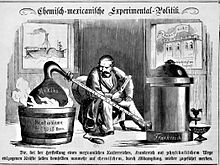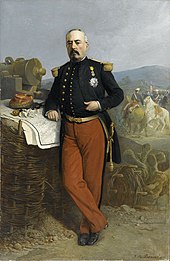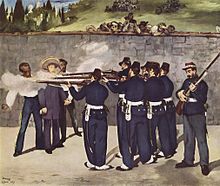French intervention in Mexico
| date | December 8, 1861 - June 21, 1867 |
|---|---|
| place | Mexico |
| output | Victory of the Republic of Mexico |
| Parties to the conflict | |
|---|---|
|
|
|
| Troop strength | |
| 38,493 French, ~ 15,000 Mexicans, |
~ 80,000 |
| losses | |
|
6,654 French, |
~ 32,000 killed or wounded |
The French intervention in Mexico was a meddling of France in the internal affairs of Mexico with the aim of helping the conservatives in Mexico to power after the already lost civil war and to install a monarchy dependent on France.
backgrounds
After the end of the great civil war between liberals and conservatives , Mexico was economically at an end in 1861. Therefore, on July 17th, the parliament decided to stop repaying the foreign debt with immediate effect. This called the major European powers on the scene, as the decision primarily concerned them.
On October 31, France, Great Britain and Spain signed the London Treaty . This stipulated that the undersigned nations would collectively collect the outstanding debts from Mexico with all necessary means.
On December 8th, a Spanish fleet from Cuba arrived in Veracruz , Mexico's largest port on the Gulf , and landed expedition troops.
course
1862: start of the intervention
Between January 6 and 8, 1862, the British and French fleets also arrived in Veracruz. At the end of February, the city of Campeche surrendered to the French.
The opportunity was propitious: since the United States was bound in the Civil War , it was impossible for it to intervene in accordance with the Monroe Doctrine in favor of Mexico. On March 5, a French expeditionary army landed under General Lorencez and advanced inland. When the British and Spanish governments realized that Napoleon III's goal consisted not of simply forcing the loan to be repaid by force, but rather of conquering Mexico (later it was even suspected that he wanted to come to the Confederate 's aid from Mexico ), they withdrew their troops.
Lorencez, meanwhile, marched with 6,000 men towards the capital. However, the Mexican general Ignacio Zaragoza temporarily forced him to retreat in the battle of Puebla with only 4,000 poorly armed soldiers. The day of this victorious battle was immediately declared a national holiday by President Benito Juárez (May 5th / “ Cinco de Mayo ”). Zaragoza died a short time later of typhus ; his troops carelessly pursued the French and were promptly defeated at Orizaba on June 14th . With this victory and the reinforcements arriving under General Forey (who replaced Lorencez as commander-in-chief on October 1) and Bazaine , the French regained the initiative. They conquered Tampico and Xalapa , the capital of the state of Veracruz , in the fall .
1863: The occupation of the capital
In January French warships shelled Acapulco and General Forey besieged Puebla and his troops. When the Mexicans tried to cut its supply lines, the famous Camerone Skirmish broke out , in which 65 Foreign Legionnaires holed up in a hacienda and fought against 2,000 Mexicans. An attempt at relief for Puebla under the Mexican General Comonfort was repulsed at San Lorenzo by General Bazaine; Puebla fell ten days later. Now that the way to Mexico City was clear, the government fled the advancing French to El Paso del Norte . A week later, the advance troops under Bazaine marched into the city on June 7th. Forey, who arrived a few days later, set up a conservative government under Juan Almonte . The nobles campaigned for a reign that consisted of Juan Almonte, José Mariano Salas and Archbishop Pelagio Antonio de Labastida y Dávalos .
1864: The establishment of the Second Empire of Mexico

Shortly after its independence, Mexico had already had an empire . The conservative junta now proclaimed the " Second Empire of Mexico " and wore its crown to Archduke Maximilian , the younger brother of the Austrian Emperor Franz Joseph I. Maximilian accepted the crown on the condition that a referendum should take place in Mexico in which his name should be held would be a choice. The Conservatives, with French help, falsified this election, reinforcing his belief that his rule was wanted by the people of Mexico. In the meantime, in Ljubljana an Austrian expeditionary force in brigade strength , under the command of the recently promoted General Count Thun-Hohenstein erected. It comprised hunter , hussar , lancer and artillery units and consisted of experienced volunteers from the Austrian army. At the same time, the Belgians, under Lieutenant Colonel Baron Van der Smissen, set up a volunteer force ( Belgian Volunteer Corps ) (Maximilian's wife and future empress was the daughter of the Belgian king), but recruited the teams from inexperienced and sometimes poorly trained men. With these troops, the new emperor landed in Veracruz on May 29th, cheered by the supporters of the conservative monarchists.
The fighting had progressed in the meantime: Bazaine, now General Forey's successor, had taken Guadalajara and General Douay the city of Zacatecas . Shortly before Maximilian moved into the capital, the French occupied Acapulco, and Durango a few days later . Bazaine was founded by Napoleon III. promoted to Marshal of France ; before the end of the year he defeated the Mexican troops in the states of Sinaloa and Jalisco .
The new emperor was less successful on the “political front”: Maximilian brought enlightened ideas with him from Europe. He passed laws against child labor , set maximum working hours and announced land reform . In addition, he represented the idea of a constitutional monarchy . All these actually positive measures, however, destroyed most of the support from the ranks of the Conservatives, while the Liberals at the grace of France already rejected his monarchy in principle. Thus its power base rested almost exclusively on the presence of foreign armed forces.
1865: The tide turns
In January, Marshal Bazaine captured the city of Oaxaca , which had been defended by General Porfirio Díaz . Díaz was captured, but escaped a short time later. The French captured Guaymas on March 29 through a successful landing operation. On April 11, the Republicans achieved another victory for the first time: the inexperienced Belgians were ambushed near Tacámbaro (in the state of Michoacán ) and lost over 300 men. Even more important was the parallel end of the Civil War . In addition to numerous enthusiastic volunteers who joined the Mexican troops in Sinaloa and Chihuahua , former, now unemployed soldiers of the Union and the Confederate came across the Rio Grande and were recruited as mercenaries . The US government , no longer hindered by the Civil War, supplied large quantities of arms and equipment to the Republicans.
At the same time, the emperor continued to hate himself: on January 25, 1862, the republican government had passed a law that made all armed resistance against the state subject to the death penalty . Maximilian now had the so-called “Black Decree” announced, according to which that law was to be applied to the Republicans who opposed his government. On October 21, a number of high republican officers and civilian dignitaries who were captured were shot dead under the law.
1866: withdrawal of the French troops
The United States now intervened more actively in the conflict. They gathered troops north of the Rio Grande and transferred naval units to the Gulf of Mexico to prevent further French reinforcements from landing.
On February 12, France and Austria on May 6, were officially ordered to withdraw the intervention troops from Mexico. Napoleon III gave in; on May 31st the general retreat of the French began. The retreating French were followed by the Mexican troops, Maximilian's remaining weaker troops mostly defeating them quickly. In July, Republican General Mariano Escobedo defeated the Austrians at Santa Gertrudis (in the state of Nuevo León ) and took Guadalajara , the capital of the state of Jalisco . In the same month the Republicans retook Matamoros , Tampico and Acapulco. Bazaine's troops gradually evacuated Monterrey and Saltillo , and in September the entire state of Sonora . Napoleon III, at whose court Maximilian's wife Charlotte was now desperate to continue supporting Maximilian, urgently advised him in writing to leave Mexico.
In the south, Díaz attacked with freshly gathered forces and won the battle of Miahuatlàn , which allowed him to occupy first Oaxaca and later large parts of Zacatecas , San Luis Potosi and Guanajuato in central Mexico .
On December 6th, the Austrian and Belgian voluntary associations were dissolved at the instigation of the respective governments. The total of 4,648 soldiers (the others were killed, wounded or captured by Republican troops in the course of the fighting) were given the choice of either returning home or joining Maximilian's imperial army. In view of the expected defeat, around 3,500 men decided to return home. The remaining approximately 1,000 men formed two regiments , the “Red Hussars ” under Colonel Khevenhüller-Metsch and the “Baron Hammerstein” infantry regiment under Lieutenant Colonel Hammerstein-Equord.
1867: The end of the Second Empire
On February 5, the last French troops withdrew from Mexico City towards Veracruz. Maximilian himself left his European units behind as a garrison and marched with his Mexican troops under General Miguel Miramón and Tomás Mejía to Querétaro , accompanied by his adjutant, the Prussian Prince Felix zu Salm-Salm . The political message of the unrealistic monarch should be that he still felt himself to be the emperor of the Mexicans and that because of the support of "his" people he was not dependent on the help of the Europeans.
While the French expeditionary forces boarded in Veracruz, the Republicans continued to advance rapidly. In March Escobedo's troops surrounded Querétaro and besieged Maximilian while Díaz took Puebla. The following month the Republicans began besieging Mexico City. On April 27, Maximilian's troops tried again unsuccessfully to break out of Querétaro, but their fate was already sealed.
On May 15, Querétaro was captured by Escobedo's troops and Maximilian was arrested, allegedly through the betrayal of Colonel Lopez (commander of Maximilian's bodyguard).
Escobedo put Maximilian and his closest confidante before a court martial , by which he was sentenced to death (mainly because of the "black decree"). Many of the European heads of state and monarchs, but also celebrities such as Victor Hugo and Giuseppe Garibaldi, reacted in horror to the message of this death sentence and wrote appeals for clemency to President Juarez , but the latter turned it down.
On June 19, Maximilian and his generals Miramón and Mejía were shot .
consequences
The “Second Empire of Mexico” ended with Maximilian's life. On June 20, 1867, the Mexico City garrison capitulated on news of his death. On July 15, 1867, Juárez entered the city in triumph.
In the following months, the constitution of 1857 , which sparked the civil war before the French intervention, was finally enacted: the vast lands of the Catholic Church in Mexico were expropriated, civil marriages were introduced and the separation of church and state consistently implemented.
The Conservative Party had made itself so unpopular through its support of France and Maximilians that it became politically insignificant.
Artistic processing
The following films are playing during this time:
- Juarez , directed by William Dieterle , USA 1939
- Vera Cruz , directed by Robert Aldrich , USA 1954
- The Treasure of the Aztecs , directed by Robert Siodmak , BRD / F / I 1965
- Sierra Charriba , directed by Sam Peckinpah , USA 1965
- The Undefeated , directed by Andrew V. McLaglen , USA 1969
- Adios, Sabata , directed by Gianfranco Parolini , Italy 1970
- A food for the vultures , directed by Don Siegel , USA / Mexico 1970
- Prairie hunters in Mexico , directed by Hans Knötzsch, TV-GDR 1988, based on motifs of the forest rose by Karl May
- Cinco de Mayo, La Batalla , directed by Rafa Lara , Mexico 2013
The following operas were written about Maximilian of Mexico:
- Maximilien , opera in 3 acts and 9 scenes. Libretto by RS Hoffman based on the drama Juárez and Maximilian by Franz Werfel ; Music by Darius Milhaud . First performed: 1932.
- Carlota , opera in 1 act. Libretto by Francisco Zendejas ; Music by Luis Sandi . First performed: 1948.
- Carlota , Opera. Libretto: unknown; Music by Robert Avalon .
literature
- Ferdinand Anders , Klaus Eggert: Maximilian of Mexico. Archduke and Emperor. Verlag Niederösterreichisches Pressehaus, Vienna 1982, ISBN 3-85326-644-4 .
- René Chartrand: The Mexican Adventure 1861–67 (= Men-at-arms Series. 272). Osprey, London 1994, ISBN 1-85532-430-X .
- Brigitte Hamann : With Emperor Max in Mexico. From the diary of Prince Carl Khevenhüller. 1864-1867. Amalthea, Vienna et al. 1983, ISBN 3-85002-169-6 .
- Johann Lubienski: The Maximilianeische state. Mexico 1861–1867. Constitution, administration and history of ideas (= research on European and comparative legal history. 4). Böhlau, Vienna et al. 1988, ISBN 3-205-05110-6 (also: Cologne, University, dissertation, 1983).
- Konrad Ratz: Maximilian and Juárez. Backgrounds, documents and eyewitness reports. 2 volumes (Vol. 1: The Second Mexican Empire and the Republic. Vol. 2: The Moments of Danger - "Querétaro Chronicle". ). Academic Printing and Publishing Company, Graz 1998, ISBN 3-201-01679-9 .




